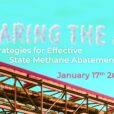As state legislative sessions begin around the country, staying up to date with the latest policy trends is essential for any climate actor. We invited a panel of experts to explore what climate policies are being introduced this year and which trends to keep an eye on — both for state legislatures and federal climate funding opportunities. Our panel of experts included Ava Gallo, Climate & Energy Program Manager at the National Caucus of Environmental Legislators (NCEL); and Jaclyn Lea, Policy Associate, and Tom Taylor, Senior Policy Analyst, working on the Climate Program Portal for Atlas Public Policy.
In this recap article, we’ll provide highlights from our expert panel’s presentations, including an overview of state climate legislative trends this year and highlights from current federal climate funding opportunities and outcomes.
Ava Gallo, NCEL
Ava Gallo serves as NCEL’s Climate and Energy Program Manager where she works to support legislators across the country on every policy topic under the climate and clean energy umbrella. Before her time at NCEL, Ava continued her passion for environmental policy and advocacy at the state level at Climate XChange, the Environmental Voter Project, and the Conservation Law Foundation.
The National Caucus of Environmental Legislators (NCEL) provides remote support to a nationwide network of over 1,200 legislators working on environmental issues across climate and energy, conservation, environmental health, and oceans. Their publicly available interactive Bill Tracking Map tracks all introduced or enacted legislation covered by their organization and can be filtered by 12 issue areas and bill status.
2024 Policy Trends: Emerging Technologies
After years of exploring solar and wind, states are leaning into emerging technologies, especially spurred by recent federal funding opportunities incentivizing clean energy technology. Geothermal is one such energy source, with over a dozen states introducing legislation addressing various pieces of the puzzle, including incentives and building up geothermal’s regulatory structure. These states are clustered in the northeast (ME, MA, NY, PA, MD) alongside MN, VA, and a handful of states in the west (AK, WA, HI, NM). This list includes some that haven’t necessarily led the charge on progressive renewable energy policy in the past; as criticisms about the intermittency of renewable energy mount, geothermal is rising as a good candidate for a dispatchable resource in the face of reliability concerns.
Various states are also introducing legislation to incentivize energy storage, especially in the west (AK, WA, OR, CA, NM, HI), alongside ME, VT, NJ, VA, MI, IA, and IL. Energy storage has become more and more cost competitive over recent years, and, like geothermal, it is gaining traction as a potential candidate for a dispatchable resource.
Agrivoltaics and community solar have also come to the forefront in recent years as a response to the question of where to build new solar. States are exploring how to work alongside farmers to utilize their lands for solar, ensuring that farmers can access the associated extra revenue of agrivoltaics while protecting agricultural lands through bills like Hawaii’s H.B. 2288. States are also looking to build out robust community solar programs, particularly with the passage of the IRA and the Solar for All grant program, through legislation like West Virginia’s H.B. 4834 and Maryland’s H.B. 0361.
2024 Policy Trends: The Grid and Utilities
Energy policy incentivizing renewable energy must be coupled with measures to ensure new renewable sources are able to be connected to the grid, and as such grid policy has started to proliferate across legislatures this year. Grid-enhancing technologies (GETs) like dynamic line ratings and advanced reconductoring aim to expand the capacity of existing transmission lines while we wait decades for new lines to be built. GET legislation already introduced this year include MA’s H.D. 4730, VA’s H.B. 862, NY’s S. 7868, and UT’s S.B. 191, ranging from requiring utilities to analyze GETs as alternatives in transmission infrastructure proceedings, to allowing cost recovery and incentives for GETs.
Microgrids and virtual power plants (VPPs) are also big grid policy topics — states are exploring how to protect and insulate communities if and when disasters cause power outages, alongside developing technology to regulate grids on a smaller scale. Bills introduced this session around microgrids and VPPs include NH’s H.B. 558, NY’s S. 4579, and NJ’s S. 250.
Utilities are another crucial piece of the climate policy puzzle, and as such states are tackling utility reform to ensure their legislatures’ goals on climate are possible for utilities. Performance-based ratemaking (PBR) attempts to change the way utilities are rewarded for their activities, aiming to incentivize utilities toward energy efficiency, distributed energy, and disaster resilience. Connecticut and Hawaii have passed PBR legislation in previous sessions, and introduced this year are VA’s H.J. 30, MD’s H.B. 0518, and NH’s S.B. 320.
States are also utilizing utility accountability legislation to prohibit utilities from charging their customers for dues to trade associations and lobbying activities, bills which passed in 2023 in Connecticut, Colorado, and Maine. Utility accountability legislation introduced this session include MD’s H.B. 0505, VA’s H.B. 792, IL’s S.B. 2885, and CA’s S.B. 938.
2024 Policy Trends: Building Decarbonization
Legislation addressing heat pumps is gaining major traction across the country, with nine states setting a multi-state goal to achieve 65 percent market penetration for heat pumps by 2030 and 90 percent by 2040 (CA, CO, ME, MD, MA, NJ, NY, OR, RI). States are exploring heat pump tax credits, such as NM’s S.B. 40, as well as incentives for utility commissions to install heat pumps, such as NJ’s S.249.
2024 Policy Trends: Transportation
Alongside utility reform is state-level Department of Transportation (DOT) reform, related to requiring state DOTs to consider their transportation projects’ emissions and vehicle miles traveled (VMT) — and in some cases setting a cap on total VMTs associated with DOT projects. Colorado and Minnesota legislatures have passed this sort of DOT reform in recent years, and are followed this year by bills like NY’s S. 1981A and MD’s S.B. 0681/H.B. 0836.
Although the IRA and BIL provide major transportation funding, states are still seeking new ways to fund transportation, especially in the face of decreasing gas tax revenue and increased need for robust investments in active and public transportation. Rideshare and retail delivery fees are one way states are filling this funding gap, in which a small fee is charged on rideshare and e-delivery services, like Uber rides and Amazon deliveries — HI, MD, RI, MA, and WA have all introduced legislation in this sphere. Some states are also exploring road user fees and electric vehicle fees to replace the gas tax, including MO, PA, WY, MN, IL, ME, NC, and HI. Introduction of all three of these different types of fees follows similar enacted legislation in Colorado and Minnesota.
Tom Taylor and Jaclyn Lea, Atlas Public Policy
Tom Taylor is a Senior Policy Analyst and brings together data, policy, and communications at Atlas. At Atlas, he works on tools including the Climate Program Portal and EV Jobs Hub. Jaclyn Lea is a Policy Associate at Atlas Public Policy, where she supports original research and analyses on electric transportation, building decarbonization, and other areas of climate policy. She works on Atlas’s data tools including the Buildings Hub and Climate Program Portal.
The Climate Program Portal, run by Atlas Public Policy, tracks federal funding opportunities (i.e. state and federal requests, deadlines, and reports) and outcomes (i.e. funding awards) from climate programs in the IRA and BIL. The Portal includes $664 billion in climate funding across 178 new programs and 115 existing programs, and adds additional analysis by tracking the awards’ “climate elements” like transit and rail, electrification, resilience, hydrogen, and more.
In terms of outcomes, the Portal has tracked $77 billion in 124 funding awards across 91 programs and almost 7,000 projects. Below is an overview of the outcomes of three key programs, tracked through the Portal:
- Rebuilding American Infrastructure with Sustainability and Equity (RAISE) program
- Clean School Bus program
- Orphaned Well Site Plugging, Remediation, and Restoration program
Rebuilding American Infrastructure with Sustainability and Equity (RAISE) Program
The RAISE program is a discretionary grant program that invests in road, rail, transit, and port projects with significant local or regional impact. To date, nearly $5 billion has been awarded through 328 projects, with California ($241m) and Washington ($226m) receiving the most total funding, and Alaska, Montana, North Dakota, and Vermont receiving the most funding per capita. Active transportation has received the most funding out of the Portal’s tracked “climate elements”; $2.8 billion has been awarded for active transportation, including record-high investments in bike and pedestrian projects with six projects receiving $25 million each. Only 60 percent of available funding has been awarded so far.
Clean School Bus Program
The Clean School Bus program awards funding to schools for electric and clean school buses. Nearly $2 billion has been awarded for 452 projects, with Illinois receiving the most total funding at $169 million and Louisiana receiving the most funding per capita at $128 million.
Orphaned Well Site Plugging, Remediation, and Restoration Program
The Orphaned Well Site Plugging, Remediation, and Restoration program provides funding to plug orphaned wells — inactive, unplugged wells with no owner on record — on federal land and for issuing grants to States and Tribes to plug wells on their land. To date, over $600 million has been awarded across 53 projects, with Oklahoma receiving the most total funding at $56 million, and Wyoming receiving the most funding per capita at $25 million.
Q&A
Q: What are some major differences in priorities between previous years and this year? Are there new policies or approaches we haven’t seen before or major trends for this year that are going to be big ticket items?
Ava Gallo: I think the past couple of years have been very IRA-focused, and we’re still seeing some of that. But states are trying to look beyond, at what’s coming next, a little bit more this year; I think transmission is that next piece of the puzzle. Also, this year, generally, are short sessions for states. I know that there are already some states talking to us, saying, well, we can’t really do very much in our 30 day session, so what can we look forward to in 2025, to pass something really big on, say, transportation, or a really big permitting bill, or something like that. So I think I’m seeing that trend more this year, of, what can we get done as piecemeal or smaller scale things — not across the board. There’s some really great and exciting things, of course, but I think that there are some states really already looking ahead to that 2025 session.
Tom Taylor: I’d add quickly, to look at the funding, there’s a lot more of the Inflation Reduction Act programs that are coming into maturity this year. So a ton more of that funding will go out, and tax credits are a big part of that. We have guidance now on tax credits, and they’re operational, I think that’s really significant. And then obviously there’s an electoral imperative at the end of the year, and I think it’s going to be a lot of storytelling about what the legislation has or hasn’t done. Our hope is that storytelling is informed by good data on where we’re seeing funding flowing, as opposed to political talking points only. But, I think that means there’ll be a lot of attention on the legacy of this legislation already. There’ll be a lot of attention on particular states, and what funding has hit the ground in those states.
Q: Can you speak to legislative efforts around state pension boards and assessing the climate risk of pension holdings?
Ava Gallo: We did a webinar on this at the beginning of January, on climate finance in the states, and it was really great at covering both the defensive work around anti-ESG legislation and also looking proactively at some of the work that states have done to more positively incorporate climate risk into their pension planning. So, I encourage you to check that out. We’re also going to be coming out with a climate finance briefing book for state legislators, so stay tuned for that. Pleiades Strategy has a great tracker of all the anti-ESG bills, it’s publicly available for this session and past sessions. That’s a really good way to track the defensive work, and we’re working together to put some bill drafting on the more pro-legislation as well. So stay tuned there, but I think that recap article and webinar is a good place to start.
Q: For the Climate Program Portal, how do you track the BIL and IRA outcomes on your dashboard, and what are your data sources?
Jaclyn Lea: We generally get these from federal and state agency funding announcements and press releases. We also subscribe to all the program newsletters, so anytime there’s an update, we make sure to keep note of that. We put that into our database, and then that updates on the Climate Program Portal, so our data is updated very frequently. Anytime something new is announced, like an award or a funding opportunity, that’ll be up there.
Conclusion
This is an exciting year for climate policy, as we see many federal climate funding programs grow into maturity with $77 billion awarded in IRA and BIL funding. As renewable energy technology continues to develop, state legislatures are looking to emerging technologies like geothermal and energy storage to meet issues of energy intermittency from sources like solar and wind, while continuing to build out agrivoltaics and community solar to ensure we can take full advantage of the opportunities solar energy provides.
The grid continues to be a major focus of state climate policy, with grid-enhancing technologies (GETs) proving a useful mechanism to expand the capacity of our current transmission lines. Microgrids and virtual power plants are also rising in popularity as communities attempt to strengthen their resilience in the face of disasters and power outages. Utility reform is another huge trend across states, especially related to performance-based ratemaking and increased utility accountability.
In terms of building and transportation decarbonization, heat pumps, rideshare and retail delivery fees, road user and EV fees, and DOT reform are coming to the forefront of state legislation this year. A successful year for state climate policy includes learning from states that have already tackled each of these policies and funding mechanisms, and strengthening our national network of state-level climate actors.
* The views and opinions expressed by our guest speakers during the webinar and summarized in this article are their own and do not necessarily reflect the views or positions of Climate XChange.








